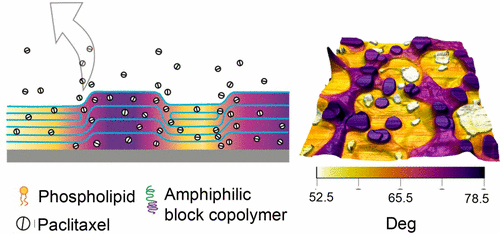当前位置:
X-MOL 学术
›
Chem. Mater.
›
论文详情
Our official English website, www.x-mol.net, welcomes your
feedback! (Note: you will need to create a separate account there.)
Three-Dimensional Microphase Separation and Synergistic Permeability in Stacked Lipid–Polymer Hybrid Membranes
Chemistry of Materials ( IF 7.2 ) Pub Date : 2017-11-01 00:00:00 , DOI: 10.1021/acs.chemmater.7b02845 Minjee Kang 1 , Byeongdu Lee 2 , Cecilia Leal 1
Chemistry of Materials ( IF 7.2 ) Pub Date : 2017-11-01 00:00:00 , DOI: 10.1021/acs.chemmater.7b02845 Minjee Kang 1 , Byeongdu Lee 2 , Cecilia Leal 1
Affiliation

|
We present new structures of soft-material thin films that augment the functionality of substrate-mediated delivery systems. A hybrid material composed of phospholipids and block copolymers adopts a multilayered membrane structure supported on a solid surface. The hybrid films comprise intentional intramembrane heterogeneities that register across multilayers. These stacked domains convey unprecedented enhancement and control of permeability of solutes across micrometer-thick films. Using grazing incidence X-ray scattering, phase contrast atomic force microscopy, and confocal microscopy, we observed that in each lamella, lipid and polymers partition unevenly within the membrane plane segregating into lipid- or polymer-rich domains. Interestingly, we found evidence that like-domains align in registry across multilayers, thereby making phase separation three-dimensional. Phase boundaries exist over extended length scales to compensate the height mismatch between lipid and polymer molecules. We show that microphase separation in hybrid films can be exploited to augment the capability of drug-eluting substrates. Lipid–polymer hybrid films loaded with paclitaxel show synergistic permeability of drug compared to single-component counterparts. We present a thorough structural study of stacked lipid–polymer hybrid membranes and propose that the presence of registered domains and domain boundaries impart enhanced drug release functionality. This work offers new perspectives in designing thin films for controlled delivery applications.
中文翻译:

脂质-聚合物杂化膜堆叠中的三维微相分离和协同渗透性
我们提出了软材料薄膜的新结构,该结构增强了基质介导的递送系统的功能。由磷脂和嵌段共聚物组成的杂化材料采用支撑在固体表面上的多层膜结构。杂化膜包含有意跨膜的膜内异质性。这些堆叠的区域可传递史无前例的增强和控制溶质在微米厚膜上的渗透性的信息。使用掠入射X射线散射,相衬原子力显微镜和共聚焦显微镜,我们观察到在每个薄片中,脂质和聚合物在膜平面内的分布不均匀,分离为富含脂质或聚合物的区域。有趣的是,我们发现有证据表明相似域在多个多层的注册表中对齐,从而使相分离成为三维。相界存在于扩展的长度尺度上,以补偿脂质和聚合物分子之间的高度不匹配。我们表明,可以利用杂化膜中的微相分离来增强药物洗脱底物的能力。载有紫杉醇的脂质-聚合物杂化膜与单组分相比具有协同增效的渗透性。我们对堆叠的脂质-聚合物杂化膜进行了彻底的结构研究,并提出注册结构域和结构域边界的存在赋予了增强的药物释放功能。这项工作为设计用于受控交付应用的薄膜提供了新的见解。相界存在于扩展的长度尺度上,以补偿脂质和聚合物分子之间的高度不匹配。我们表明,可以利用杂化膜中的微相分离来增强药物洗脱底物的能力。载有紫杉醇的脂质-聚合物杂化膜与单组分相比具有协同增效的渗透性。我们对堆叠的脂质-聚合物杂化膜进行了彻底的结构研究,并提出注册结构域和结构域边界的存在赋予了增强的药物释放功能。这项工作为设计用于受控交付应用的薄膜提供了新的见解。相界存在于扩展的长度尺度上,以补偿脂质和聚合物分子之间的高度不匹配。我们表明,可以利用杂化膜中的微相分离来增强药物洗脱底物的能力。载有紫杉醇的脂质-聚合物杂化膜与单组分相比具有协同增效的渗透性。我们对堆叠的脂质-聚合物杂化膜进行了彻底的结构研究,并提出注册结构域和结构域边界的存在赋予了增强的药物释放功能。这项工作为设计用于受控交付应用的薄膜提供了新的见解。载有紫杉醇的脂质-聚合物杂化膜与单组分相比具有协同增效的渗透性。我们对堆叠的脂质-聚合物杂化膜进行了彻底的结构研究,并提出注册结构域和结构域边界的存在赋予了增强的药物释放功能。这项工作为设计用于受控交付应用的薄膜提供了新的见解。载有紫杉醇的脂质-聚合物杂化膜与单组分相比具有协同增效的渗透性。我们对堆叠的脂质-聚合物杂化膜进行了彻底的结构研究,并提出注册结构域和结构域边界的存在赋予了增强的药物释放功能。这项工作为设计用于受控交付应用的薄膜提供了新的见解。
更新日期:2017-11-01
中文翻译:

脂质-聚合物杂化膜堆叠中的三维微相分离和协同渗透性
我们提出了软材料薄膜的新结构,该结构增强了基质介导的递送系统的功能。由磷脂和嵌段共聚物组成的杂化材料采用支撑在固体表面上的多层膜结构。杂化膜包含有意跨膜的膜内异质性。这些堆叠的区域可传递史无前例的增强和控制溶质在微米厚膜上的渗透性的信息。使用掠入射X射线散射,相衬原子力显微镜和共聚焦显微镜,我们观察到在每个薄片中,脂质和聚合物在膜平面内的分布不均匀,分离为富含脂质或聚合物的区域。有趣的是,我们发现有证据表明相似域在多个多层的注册表中对齐,从而使相分离成为三维。相界存在于扩展的长度尺度上,以补偿脂质和聚合物分子之间的高度不匹配。我们表明,可以利用杂化膜中的微相分离来增强药物洗脱底物的能力。载有紫杉醇的脂质-聚合物杂化膜与单组分相比具有协同增效的渗透性。我们对堆叠的脂质-聚合物杂化膜进行了彻底的结构研究,并提出注册结构域和结构域边界的存在赋予了增强的药物释放功能。这项工作为设计用于受控交付应用的薄膜提供了新的见解。相界存在于扩展的长度尺度上,以补偿脂质和聚合物分子之间的高度不匹配。我们表明,可以利用杂化膜中的微相分离来增强药物洗脱底物的能力。载有紫杉醇的脂质-聚合物杂化膜与单组分相比具有协同增效的渗透性。我们对堆叠的脂质-聚合物杂化膜进行了彻底的结构研究,并提出注册结构域和结构域边界的存在赋予了增强的药物释放功能。这项工作为设计用于受控交付应用的薄膜提供了新的见解。相界存在于扩展的长度尺度上,以补偿脂质和聚合物分子之间的高度不匹配。我们表明,可以利用杂化膜中的微相分离来增强药物洗脱底物的能力。载有紫杉醇的脂质-聚合物杂化膜与单组分相比具有协同增效的渗透性。我们对堆叠的脂质-聚合物杂化膜进行了彻底的结构研究,并提出注册结构域和结构域边界的存在赋予了增强的药物释放功能。这项工作为设计用于受控交付应用的薄膜提供了新的见解。载有紫杉醇的脂质-聚合物杂化膜与单组分相比具有协同增效的渗透性。我们对堆叠的脂质-聚合物杂化膜进行了彻底的结构研究,并提出注册结构域和结构域边界的存在赋予了增强的药物释放功能。这项工作为设计用于受控交付应用的薄膜提供了新的见解。载有紫杉醇的脂质-聚合物杂化膜与单组分相比具有协同增效的渗透性。我们对堆叠的脂质-聚合物杂化膜进行了彻底的结构研究,并提出注册结构域和结构域边界的存在赋予了增强的药物释放功能。这项工作为设计用于受控交付应用的薄膜提供了新的见解。











































 京公网安备 11010802027423号
京公网安备 11010802027423号